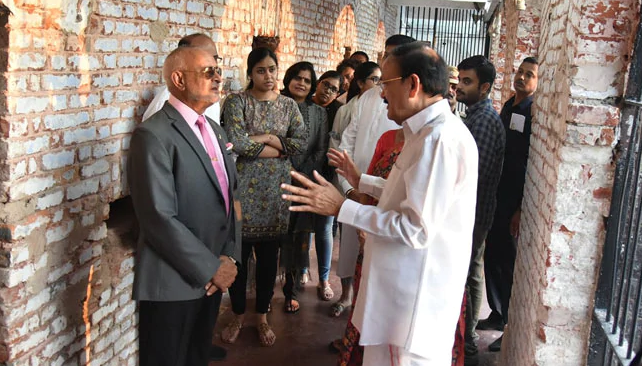Vice President Visits Cellular Jail, Calls For Organizing Student Visits To Historic Places Linked To Freedom Struggle
In a Facebook Post, the Vice President described his visit to the solitary confinement cell of Vinayak Damodar Savarkar as a "humbling experience".

Credits : www.ndtv.com
New Delhi: The Vice President M Venkaiah Naidu today urged the Union education ministry and all State governments to organize visits of students to the Cellular Jail in Port Blair and other historical places associated with the freedom struggle.
The Vice President visited the Cellular Jail, including the solitary confinement cell occupied by Vinayak Damodar Savarkar, and paid his tributes at the martyrs' column, to the valiant freedom fighters, who were subjected to inhuman treatment during their incarceration at the time of freedom struggle.
In a Facebook Post, the Vice President described his visit to the solitary confinement cell of Vinayak Damodar Savarkar as a "humbling experience".
He said that it (the Jail) was a stark reminder of the cruel and sadistic treatment meted to freedom fighters, who refused to abandon their love for the motherland. Fired by their patriotic passion and an iron resolve to free the country from an alien rule, the brave freedom fighters never gave up, he added.
Mr Naidu said that the Cellular jail was a reminder of how hard-won and precious our freedom is.
Stating that the Jail was now a place of pilgrimage for all those who love the country and value freedom, the Vice President described it as a symbol of resistance to the ills of colonialism.
While reminding the younger generation of the countless stories of sacrifices made by our courageous freedom fighters, he expressed confidence that a visit to the Cellular Jail would inspire them to strive for the greater glory of the country and to always protect the unity and integrity of this great nation.
Completed in the year 1906, Cellular Jail, also known as 'Kala Pani' or the 'Black waters', derived its name from the small, individual cells that housed prisoners.
Of the three-pronged tactic of hunger, torture and isolation, it was the isolation from fellow beings that acted as the harshest of punishments to inmates.
Apart from Vinayak Damodar Savarkar, many distinguished people were imprisoned in the Cellular Jail. They included Diwan Singh Kalepani, Fazl-e-Haq Khairabadi, Yogendra Shukla, Batukeshwar Dutt, Maulana Ahmadullah, Movli Abdul Rahim Sadiqpuri, Ali Ahmed Siddiqui, Maulvi Liaquat Ali, Babarao Savarkar, Sachindra Nath Sanyal.
The other imprisoned revolutionaries, on who cases were foisted by the British in connection with Alipore Bomb case, Nasik Conspiracy, Lahore Conspiracy Case and Chittagong Armory Raid Case, were given life sentences and had faced a lot of brutality and hardship.
Instead of calling them as conspiracy cases as referred by the British, we should describe them as 'freedom struggle cases', the Vice President said.
The Cellular Jail also houses the Eternal Flame and Martyrs' Column as a tribute. Originally the jail was a massive three-storeyed structure with seven wings radiating from central fulcrum on which stood a watch tower.
Back to All Educational News
Share This:
Source: www.ndtv.com
